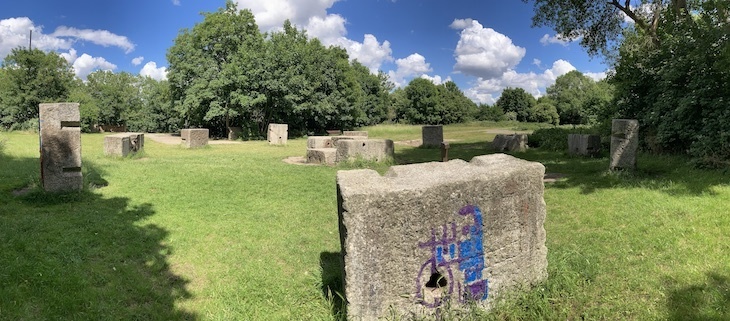
One does not simply stumble upon Hackney Henge.
Those who seek its lithic embrace must take the canal tow path, duck into a former waterworks, then venture down the lesser of two tracks through deepening undergrowth.
And there it sits...

You're looking at a torus of stones, ten in number, positioned around a throne-like centrepiece. It is modestly magnificent. But what is it?
These latter-day menhirs are neither ancient nor imposing. They align with no equinox nor solstice. No connection can be found to any religion or druidic practice. Yet Hackney Henge is worth seeking out if only for its unexpectedness. And their is hidden power here, as we shall see...

Watery origins

The stone circle can be traced back all the way to the last millennium; 1990 to be precise. The project was conceived by artist Paula Haughney who arranged the circle from stones already on the site.
And it's a site with a long history of industry and purpose. From the 18th century, mighty water wheels stole energy from the river to drive machinery. Later, a giant waterworks occupied the peninsula. The Middlesex Water Beds provided clean water to the Victorian populace, part of a massive investment in sanitation following the cholera epidemics and Great Stink of the mid-19th century.
This was a place where dirty river water was strained into something vaguely drinkable, thanks to gravel and sand filtration. The effect on public health was incalculable and every bit as important as the more-celebrated sewers of Joseph Bazalgette.

The Middlesex Filter Beds served London for almost a century, finally closing in 1969. Then nature set in. The abandoned water works became a secret garden, little visited by humans. The site was eventually turned into a managed nature reserve in the 1980s, under the auspices of the Lea Valley Regional Park.
The stone circle was part of that transformation. Its mighty granite blocks were recovered from the foundations of an engine house, which once pumped water into the beds.
Today, the nature reserve is a quiet, contemplative place. It gets some footfall, thanks to its location on the Capital Ring footpath, but otherwise this is the domain of the heron, the wren and the warbler.
Evolving stones

Look carefully at the stones, and you will see patterns in light relief. The central throne, for example, has a fishy theme, in keeping with the site's riverine history. Elsewhere, the stones include fragments of metal and are punctured by holes and divots. There is much to explore in the detail.
Artist Paula Haughney specialises in formidable stone sculptures. You might have seen, for example, her monumental Ram and Magpie near Spitalfields Farm. She also carved into two blocks from John Rennie's old London Bridge, which can now be seen near Waltham Abbey. Hackney Henge, properly called 'Nature's Throne' is her largest work.

Though solid and monumental, the henge is also evolving. The stones attract lichen as the seasons take their toll. Humans, too, leave their mark. The throne's seat is charred, as though sacred rites are performed on the slab.

Later, cruder artists supplement Haughney's work. Wander round the backs of the stones, and you're likely to see the daubs and glyphs of taggers. One painting, in the shape of an eye, invites you to bend down and peer through its pupil — an oculus that points towards the central throne.

These stones quietly build up their own mythologies. The ancient form of a stone circle seems to hum with energy and purpose. By chance, the henge sits directly over one of the London Power Tunnels. High-voltage electricity permeates the land. Hackney Henge is a Marvel origin story waiting to happen.
Granite does not dissolve with age. Perhaps, centuries hence, Hackney Henge's origins will be forgotten and this pump-house-turned-art-project will tantalise our descendants.
All images by the author.



